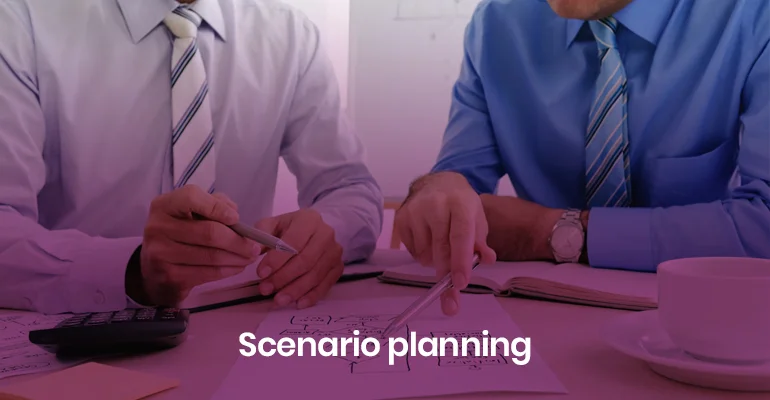By basing their judgment on objective techniques and adding a little imagination by means of their own intuition, researchers are often able to create a series of alternative future scenarios. Each of these alternatives needs to be consistent and to have some probability of occurring. The purpose of such forecasting is to stimulate creative thinking and opportunities for managers to look ahead.
Strategies and strategic planning are inherently concerned with the future. Because of this the strategic planner is often concerned to assess the future as an input to developing corporate strategic plans. This is particularly true in the area of environmental analysis in corporate planning. The corporate planner must attempt to assess how the environment of the organisation might be configured in the future so as to develop corporate plans to take account of these envisaged configurations. A technique which has been widely used in this respect is the technique of using scenarios in developing plans for the future.
Scenarios comprise of detailed and plausible views of how the business environment of an organisation might develop in the future couched in such a way that the corporate planner is able to develop a range of strategic objectives and actions to best deal with the envisaged futures.
It is important to stress that scenarios are not the same as forecasts. Forecasts are made on the basis of assumptions that the future can be predicted whereas scenarios are generated on the assumption that it can’t.
Scenarios are especially useful in the following circumstances:
(a) Where it is important to take a long-term view of strategy
(b) Where there are a limited number of key factors influencing strategic options
(c) Where there is a high level of uncertainty about such influences.
Unlike a forecast, which tries to predict precisely what the future will be, scenarios represent simply plausible narratives of how the future might turn out.
So, how are scenarios built and used in the corporate planning process? Using the example of an oil company we can first consider the steps in building scenarios.
(a) The first step in building scenarios is to establish the purpose of the scenario, i.e. what is the scenario to consider and be used for? The purpose may be wide-ranging (such as “what will the energy market look like in the future?”), or more focused, to support key decisions facing the organisation (such as “should we invest in developing solar-powered energy sources?”).
(b) The second step is to identify the strategic issues or drivers of change in the environment, i.e. the factors in the environment which may affect the future with respect to the purpose of our scenario and about which we are uncertain… Usually these factors are readily identifiable: continuing our example, key drivers about which we are uncertain might include oil costs, discovery of new reserves; environmental protection legislation, etc. The number of factors identified at this stage of scenario-building should be kept relatively small, since the number of possible scenarios can quickly become unmanageable. Those drivers selected should be those that have the greatest impact on possible future strategies for the organisation and about which we are most uncertain. Clearly the selection of strategic issues or drivers of change is crucial to the development of scenarios and therefore should ideally use the most expert and informed managers inside (or sometimes even outside) of the organisation. Membership of the scenario-building team is a crucial factor.
(c) Having identified the key driving factors in our scenario analysis, the next step is to identify different possible plausible futures by factor. Again continuing our example, the scenario team can assess, say, the likely future possibilities regarding environmental protection legislation.
(d) The fourth step is then to combine to build scenarios of plausible configurations of factors, considering the possible range of permutations and combinations of the driving factors selected so as to build “complete pictures” of a possible future. The planner can then develop plausible configurations of developments of driving factors from the previous stage, developing and fleshing out the narrative of the predicted scenarios and assessing possible likely outcomes for each.
When this has been done then the corporate planner can begin to assess the likely implications of the scenarios developed for corporate strategic plans. This may encompass determining objectives to deal with future scenarios, assessing strategic options for the future, and in particular for developing possible contingency plans.
These, then, are the main steps in developing and using scenarios in the corporate planning process. There are a number of other considerations in the process, such as determining the membership of the scenario-building team; the timescales for scenarios; and the number of scenarios to be developed. All of these affect the nature and effectiveness of scenarios.
Scenarios have proved to be a useful approach to dealing with unpredictable and volatile environments where conventional techniques of forecasting have proved ineffective and inappropriate. Again, it is important for the planner to remember that scenarios are not forecasts but they can be a very creative and useful approach to trying to assess the implications of an uncertain future environment.
-
- Within the scheme of scenario planning we also have:
Cross-impact analysis, which identifies a set of key trends and asks the question “if A occurs, what impact will this event have on other trends?” and - Demand/hazard forecasting, which sets out to identify major events which would have an impact on the organisation. Each event is rated for its convergence with other major events taking place in society and its appeal to the public:
- Within the scheme of scenario planning we also have:
(a) the greater the event’s convergence and appeal the more likely it is to happen;
(b) the higher-rated events are the ones which management takes more account of.
-
-
- Subjective forecasting, which helps managers to make strategic judgments about future events, to identify the best strategic route to take, and then to make contingency plans to deal with them. Those events which are closer in time will be given more accurate levels of probability of their occurring. Eventually, all events will have occurred and can then provide databases from which objective forecasts can be made for future events.
-
By an iQualify UK staff writer.
1. Achieving Quality
In the classroom, there are children with behavioural, emotional, social or other challenges that may limit their learning abilities. Therefore, when the teacher identifies their weaknesses and applies measures to overcome them, their learners acquire education without any barriers. This ensures that the challenged learners do not feel left out or discriminated from the rest.
2. Developing Talents
The needs in the classroom are not always negative. Learners, especially young ones, are usually undergoing the process of understanding their skills. The teacher, however, is experienced enough to tell that a certain learner has a particular skill or talent. In this case, skills and talents become needs too because they require nurturing to develop. Therefore, once the teacher identifies them and provides the essential support to develop them, they help the learners to discover and grow them.
3. Creating Interest
Identifying and meeting individual learner needs boosts their morale and encourages them. In some cases, the learner does not gain much from mass instruction. As such, when the teacher provides individually prescribed instruction (IPI) it significantly helps many learners to understand and grasp educational concepts. This applies more to subjects such as mathematics and art. If a student feels supported by their tutor, they develop rather than lose interest in learning.
4. Planning Classroom Activities
Once the teacher is familiar with the personal needs of their learners, they can easily plan their day-to-day classroom activities, so they cater to all of them. For instance, the teacher will know how to plan the timetable for counselling, individual tutoring, group interactions and general supervision. In short, each activity targets the needs of specific students such that by the end of the day, every learner’s needs are fully met.
5. Organising the Classroom
The best way for a teacher to organise the classroom is by first identifying the characteristics of each learner. The learners that need more personalised instruction can sit closer to the teacher. If a student has visual difficulties, the teacher can sit him or her closer to the blackboard. They can also sit near a door or window where there is an abundance of light. In a nutshell, the needs of the learners should determine the availability of supplementary material, accessibility of equipment and supplies, as well as the seating arrangements.
Evidently, it is paramount that the teachers identify and meet individual learner needs when teaching. This is because it allows them to devote their energies beyond regular teaching into effective education that is supportive and considerate for each learner. In this way, the students are motivated, supported, empowered, and developed because optimum learning conditions are created.
By an iQualify UK staff writer

